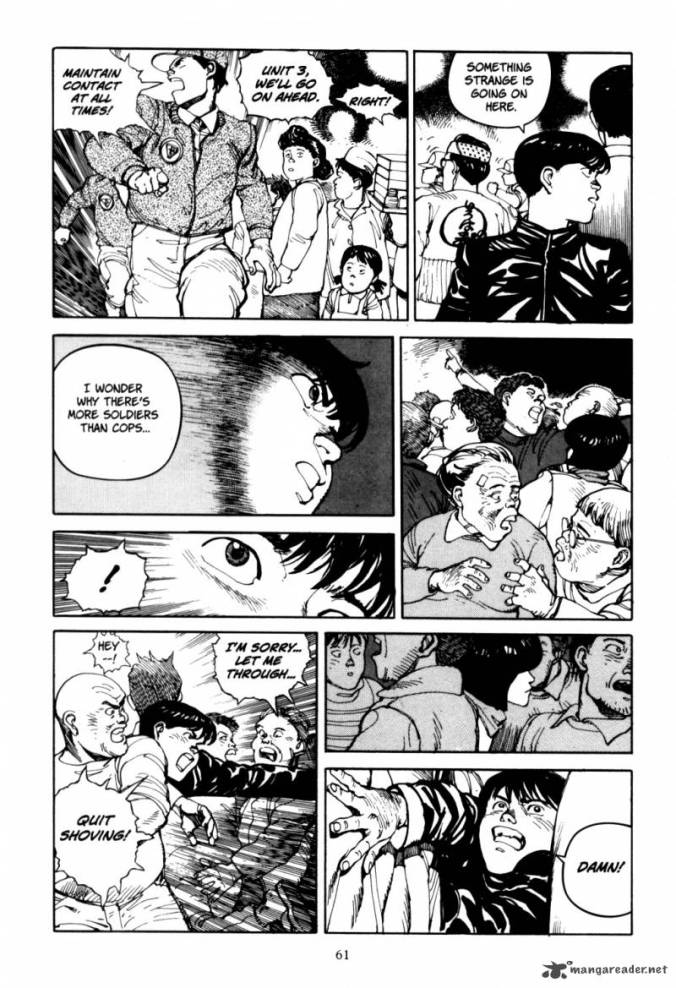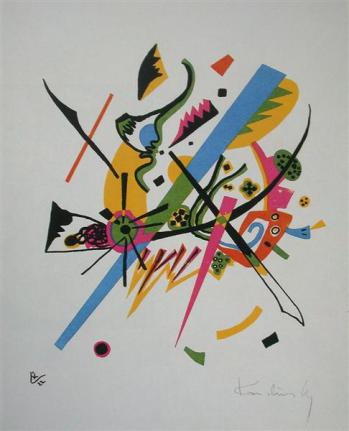Akira is a Japanese manga created by Katsuhiro Otomo that was released from 1982 to 1990 in six volumes. The series is set in Tokyo in the year 2019, after the breakout of World War III. This comic discusses the evolution of Japan’s youth culture in the event of a monstrous disaster, and the role of the government during these times. Throughout the story, Otomo demonstrates an attempt at anarchy as well as the perseverance Japan’s youth contains and how important it can be in times of war through the search for an inhuman entity that goes by Akira.

In this scene, the character is chasing after another character but happens upon a group of soldiers searching the streets. The character notes that this scene is unusual in their world since there are more soldiers than there are cops. Usually, the connotation for soldiers is that they are deployed by the national government, while cops are deployed by the city or state government. Therefore, in this scene, it demonstrates the peculiarity of having the national government be so involved in the daily lives of the people. Throughout this chase scene as well, there seems to be a lack of trust between the citizens and the soldiers, as they are more afraid of being caught by the soldiers than fighting amongst each other. A common trope in post-disaster future stories is a criticism of our current government. In Akira, the society has developed in that the government is not a source of reliability and cannot be trusted. What Otomo relays with this is that in Japan’s future, it is possible that the people will discover all of the fallacies produced by the government and rebel when the government proves to be untrustworthy when they are needed the most by the people.
 The way Ozomo chose to catapult this futuristic environment is through a body invasion. The main drive of all of the characters in the story is the desire to find Akira. Akira had been the reason why Tokyo was completely destroyed so many years ago, so in order to preserve Neo-Tokyo, the characters set out on controlling Akira’s powers to prevent another mass disaster. In Ollivier Dyens article, Cyberpunk, Technoculture, and the Post Biological self, they illustrate the feeling that they “understood that the body [they were] raised to believe in — this unique, stable, intelligent body, this singular body that sheltered [them], was disappearing” when a post-biological character was presented. In combining this notion with Akira, the appearance of the character, Akira, represents the comfortability and stability of a nation being shaken up. This ties into the instability of government, as Akira threatens the soldiers and the government so much that they employ anyone in order to stop it. It also marks the shift in Japanese culture. Where in the first explosion, the society transformed itself into Neo-Tokyo, the threat of a second Akira ignites the appearance of the Japanese youth rising up against those who dismiss their strength. In Japanese culture, today, there is a common concept that the younger generation must completely obey to the older generation. A main theme in Akira, is the rebellion of the youth and bringing their fortitude into a situation that would typically be seen as adult work.
The way Ozomo chose to catapult this futuristic environment is through a body invasion. The main drive of all of the characters in the story is the desire to find Akira. Akira had been the reason why Tokyo was completely destroyed so many years ago, so in order to preserve Neo-Tokyo, the characters set out on controlling Akira’s powers to prevent another mass disaster. In Ollivier Dyens article, Cyberpunk, Technoculture, and the Post Biological self, they illustrate the feeling that they “understood that the body [they were] raised to believe in — this unique, stable, intelligent body, this singular body that sheltered [them], was disappearing” when a post-biological character was presented. In combining this notion with Akira, the appearance of the character, Akira, represents the comfortability and stability of a nation being shaken up. This ties into the instability of government, as Akira threatens the soldiers and the government so much that they employ anyone in order to stop it. It also marks the shift in Japanese culture. Where in the first explosion, the society transformed itself into Neo-Tokyo, the threat of a second Akira ignites the appearance of the Japanese youth rising up against those who dismiss their strength. In Japanese culture, today, there is a common concept that the younger generation must completely obey to the older generation. A main theme in Akira, is the rebellion of the youth and bringing their fortitude into a situation that would typically be seen as adult work.

A prevalent motif that can be seen throughout the manga is that the youth is constantly disrespected and disregarded by the adults. In this scene, one of the younger characters has been seriously hurt in a vehicular accident. When the rest of the characters turn to the soldiers for help, the soldiers look at the injury as merely an accident “by some kids”. They clearly deemphasize the severity of the situation when calling it in. In many different scenes, there is obvious dissonance between the older and younger generation in this society. These conflicts occur out of one of the groups being coarse towards the other. Otomo establishes that the two groups work the best though, when they are collaborating with each other. In the chase after Akira, they make the most progress when the adults allow the youth to stand on the same level of power as them. Therefore, there is a critique of Japan’s current culture in which the younger generation’s opinions and ideas are neglected in favor of the older generation.
This scene can also demonstrate the unnecessary appearance of the government within the society. Although the soldiers are occupying every street corner in Neo-Tokyo, they seem to not care about the citizens’ well-being. Where they just witnessed an accident, they make no moves to provide their assistance even though the citizens are looking towards them for help. So, not only is their appearance unwarranted, it is also not needed as they do not help the masses in keeping the peace. In fact, in many scenes, they seem to be creating more havoc within the city than there was without the soldiers.
Overall, Akira is a commentary on the current state of Japan’s government and cultural attitudes. The novel explains that Japan’s government is extremely inconsistent and is unable to be stable in a time of crisis. The defiance of the youth should be seen as an asset rather than dishonor towards their elders. In time, Japan’s masses will understand this and eventually, they will uproot the corruption that exists in the system. This manga can definitely be seen as a criticism towards Japan post-World War II, as it takes place in the event of World War III which began because of Japan’s incompetence to control Akira the first time. What Otomo says about Japan’s future is that the current society is inefficient due to these two things and they cannot prosper if a World War III were to happen because this government and this culture would not be prepared for the event.
Works Cited:
Dyens, Ollivier. “Cyberpunk, Technoculture, and the Post-Biological Self.” CLCWeb: Comparative Literature and Culture, vol. 2, no. 1, Jan. 2000, doi:10.7771/1481-4374.1061.
Otomo, Katsuhiro. Akira, Volume 1. Dark Horse Comics, 2000.
Advertisements Share this:





